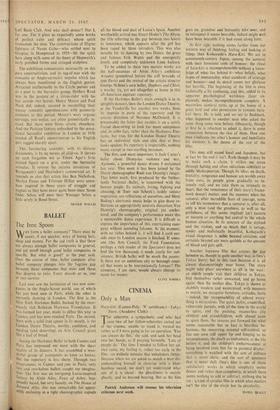Hara-kiri. (Cameo-Poly; 'X' certificate.)--Tokyo Story. (Academy Club.)
'THE usherette, a sympathetic soul who had I seen two of her fellow-usherettes carted out of the cinema, unable to stand it, treated me rather as if I were going in for an operation. 'You can always do this,' she said, and sank her head into her hands, as if praying fervently. 'Lots of people do.' The time I needed to follow her ad- vice came, my feeling is, rather too early in the film -an msthetic mistake that unbalances things. Because when we are asked to watch a man dis- embowelling himself in close-up with a blunt bamboo sword, we don't yet understand what any of it is about: the ghastliness is merely ghastly, and 'so beyond bearing. But as the film
Patrick Anderson will resume his television criticism next week. goes on, grandeur and humanity take over, and in retrospect it seems bearable, indeed might well have been bearable if it had come along later.
At first sight nothing seems farther from our western way of thinking, feeling and looking at things than Kobayashi's Hat.a-Kiri. We are in seventeenth-century .Japan, among the samurai with their ferocious code of honour; the ritual of hara-kiri is incomprehensible without a know- ledge of what lies behind it— what beliefs, what hopes of immortality, what standards of courage and honour—and its detail seems not glorious but horrific. The beginning of the film is even technically a bit confusing, and this, added to its apparent psychological weirdness (later ex- plained), makes incomprehension complete. A masterless samurai turns up at the house of a great lord and asks permission to commit hara- kiri there. He is told, and we see in flashback, what happened to another man who asked the same thing some time before. Obviously, though at first he is reluctant to admit it, there is some connection between the two of them. How one man vindicates the other's honour and humiliates his enemies is the theme of the rest of the film.
This may still sound local and Japanese, but in fact by the end it isn't. Rash though it may be to make such a claim, it strikes me (even through halting and often ridiculous subtitles) as oddly Shakespearian. Though its ideas on death, brutality, vengeance and honour are worlds away from ours, its people grow gradually so in- tensely' real, and we take them so intensely to heart, that the remoteness of their story's frame- work doesn't matter, and the moment when the samurai, after incredible feats of courage, turns to tell his tormentors that a samurai is, after all, only a man (and the greatness, as well as the pitifulness, of this seems implied) isn't eastern or western or anything but central to the whole human situation. In its mixture of the stylised and the violent, and so much that is savage, tender and realistically beautiful, Kobayashi's visual eloquence is noble beyond criticism, and certainly beyond any mere quibble at the amount of blood and guts spilt.
Another Japanese film that crosses the gap between us, though in quite another way, is Ozu's Tokyo Story; but in this case because it is all almost disconcertingly near home. The story might take place anywhere at all in the west: an oldish couple visit their children in Tokyo, find themselves rather unwanted, and go home again; then the mother dies. Tokyo is shown as shabbily modern and westernised, with manners to match; we recognise furniture, attitudes, hurts —indeed, the recognisability of almost every- thing is miraculous. The quiet, polite, countrified, vulnerable parents, with all the time in the world to spare, and the pushing, mannerless city children and grandchildren, with almost none to spare them, the reasons put forward for what seems reasonable but in fact is heartless be- haviour. the unnerving oriental self-control, so like our own stiff upper tip and longing to be inconspicuous, the death as undramatic as the life before it, and the children's embarrassment at being involved even that far in parental drama : everything is watched with the sort of stillness that is never static, and the sort of quietness that is :never dull. Ozu's film is one of those satisfactory works in which simplicity seems denser and richer than complexity, in which there seems nothing to add or subtract, nothing else to say : a kind of circular film in which what matters isn't the size of the circle but its circularity.
ISABEL WILILY














































 Previous page
Previous page